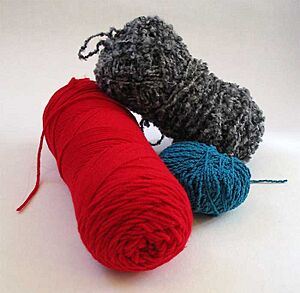Yarn facts for kids
Yarn is a long, thin strand made from fibers that have been twisted or pressed together. Think of it like many tiny hairs spun into one strong string. Yarn is used to make cloth by knitting, crocheting, or weaving.
You usually buy yarn in a shape called a skein. This shape helps keep the yarn from getting tangled or knotted.
Yarn can be made from many different materials. Some are natural, like wool, cotton, or silk. Others are man-made, like acrylic. Sometimes, different kinds of fibers are mixed together to make a special blend.
Yarns come in many different thicknesses, from very fine to super thick. These thicknesses are often called "weights." Examples include lace, fingering, sport, worsted, and bulky. Very fine yarn is called thread. Thread is mostly used for sewing and embroidery.
Contents
How Yarn is Made
Yarn is made by taking short or long fibers and twisting them together. This process is called spinning. Spinning makes the fibers strong and continuous. In the past, people spun yarn by hand using tools like spinning wheels. Today, most yarn is made in factories using big machines.
Some yarn is also made by a process called felting. This is where fibers are pressed and matted together using heat, moisture, and pressure. This creates a dense fabric without needing to spin or weave.
Types of Yarn
Yarn can be sorted by what it's made from and how thick it is.
What Yarn is Made From
- Natural Fibers: These come from plants or animals.
* Wool: Comes from sheep and other animals like goats (cashmere, mohair) or alpacas. It's warm and stretchy. * Cotton: Comes from the cotton plant. It's soft, breathable, and good for warm weather. * Silk: Comes from silkworms. It's smooth, shiny, and strong.
- Synthetic Fibers: These are man-made.
* Acrylic: A common man-made fiber. It's often used because it's soft, warm, and easy to care for. * Blends: Many yarns mix natural and synthetic fibers. This can give the yarn the best qualities of both. For example, a wool-acrylic blend might be warm like wool but easier to wash like acrylic.
Yarn Thicknesses (Weights)
Yarn comes in different thicknesses, called "weights." The weight tells you how thick the yarn is. Thicker yarns make bigger, warmer items quickly, while thinner yarns are good for delicate projects.
- Lace and Fingering: Very thin yarns, often used for delicate items like shawls or socks.
- Sport and DK (Double-Knit): Medium-thin yarns, good for sweaters and baby clothes.
- Worsted and Aran: Medium-thick yarns, very popular for many projects like hats, scarves, and blankets.
- Bulky and Super-Bulky: Very thick yarns, great for quick projects like chunky blankets or warm hats.
What Yarn is Used For
Yarn is used in many creative ways to make fabrics and other items.
Knitting and Crocheting
Knitting and crocheting are popular crafts that use yarn to create fabric.
- Knitting: Uses two needles to make loops of yarn that connect to each other.
- Crocheting: Uses one hook to make loops of yarn.
Both methods can create many different items, from sweaters and scarves to blankets and toys.
Weaving
Weaving uses yarn to make fabric on a loom. Two sets of yarn are interlaced over and under each other. This is how most cloth for clothes and home goods is made.
Sewing and Embroidery
Very thin yarn, called thread, is essential for sewing. It holds pieces of fabric together. Thread is also used for embroidery, which is decorating fabric with stitches to create pictures or patterns.
Images for kids
-
A restored machine winding cotton at Quarry Bank Mill in the UK.
-
A Spinning Jenny, an important spinning machine from the Industrial Revolution.
See also
 In Spanish: Hilo para niños
In Spanish: Hilo para niños

















